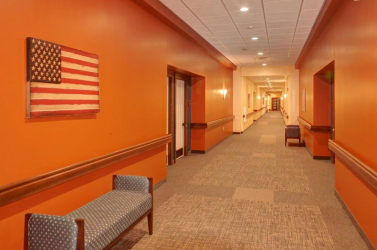
The newly-remodeled lobby of the skilled nursing facility looked more like a luxury hotel. The colors were muted, earth-tone hues, low light illuminating the front desk. It was welcoming to the daughter who was trying to find the most hospitable and comfortable environment for her mom. It was inviting, but it wasn’t safe.
As a Certified Dementia Practitioner, I know that whether the geriatric resident has low-vision or not, the ability to see boundaries and borders diminishes with the progression of dementia. As geriatric-care professionals, we know that while “Alzheimer’s Disease” defines the most prevalent type, it’s only one of many categories of dementia.
A recent study found a link between blue eyes, macular degeneration, and Alzheimer’s disease. The study doesn’t show cause-and-effect; it shows a connection.
As dementia progresses, the pupils may react more slowly to light. The visual field shrinks. Vision can become blurry. Depth perception can be reduced because the brain with dementia can cause the person to see only out of one eye. As a Physical Therapist, I have seen people living with dementia stop walking when they reach the border of the brown carpet where it meets the white floor. Why? Because to that person, it looks like they’re about to walk off a cliff.
I used to work on a rehab floor that had three wings. Each wing was decorated in primary colors. One wing had yellow floors, yellow wallpaper, yellow furnishings. The next had red floors, wallpaper, and furnishings. The third was entirely in blue. We referred to them by their colors.

Every single resident and patient on that floor knew exactly where their room was. Those with dementia, those with low-vision, and those who were younger and getting their knees replaced all referred to their units by color. When the building sold, all the units were decorated in the same muted, aesthetically pleasing tones. And everyone got lost.
We all use three inputs to maintain our balance:
• Visual: When you open your eyes, your brain automatically adjusts to what you see and keeps you upright
• Proprioceptive/sensorimotor: The firmness of the floor, the surface you’re standing on. Is it moving? Is it spongy?
• Vestibular: The “bubble level” in your inner ear tells you when you’re upright. Nearly everyone over 70 has some vestibular dysfunction.
For those living with dementia, vestibular dysfunction and vision disturbances are part of their lives. Throw in diabetes and all three factors are diminished. It’s important to ensure the visual environment supports their safety.
The best design includes bright colors, contrasting colors between the carpet and the furniture, lots of natural light, and contrasting borders. The visibility of the angle where the wall meets the carpet is important to ensure clearance and visibility of doorways. Low light may help the 50-year-old daughter make a decision, but it’s not safe for her mom.
When our design aesthetic outweighs the needs of the person who requires care, we endanger their safety and may even be the cause of falls, fractures, and everything that follows. Of course, it’s important for the look of a building to appeal to the decision-maker, but it also needs to ensure the safety and function of the resident.
Jean Wendland Porter, PT, CCI, WCC, CKTP, CDP, TWD is the regional director of therapy operations at Diversified Health Partners in Ohio.
The opinions expressed in McKnight’s Long-Term Care News guest submissions are the author’s and are not necessarily those of McKnight’s Long-Term Care News or its editors.





